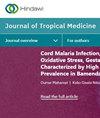Prevalence of Malaria Parasite among Pregnant Women Attending to Saudi Kassala Teaching Hospital in Kassala State, Eastern Sudan
IF 2.1
4区 医学
Q3 PUBLIC, ENVIRONMENTAL & OCCUPATIONAL HEALTH
引用次数: 0
Abstract
Objective. Malaria during pregnancy is a priority area for malaria research and control as pregnant women represent a high risk group for severe malaria, and the presentation of malaria during pregnancy varies according to the level of transmission in the area; so the aim of this study is to determine the prevalence rates of malaria parasite among pregnant women attending to Saudi Kassala Teaching hospital in Kassala state, 2022. Methods. A cross-sectional study was carried out in Saudi Kassala Teaching hospital in Kassala State. This study involved one hundred and eighty-five blood samples collected from pregnant women who was then examined by using blood films and ICT for malaria, and the data were collected by a structured questionnaire and analyzed using SPSS version 21. Results. The prevalence of malaria among pregnant women was 2.2% (95% CI: 0.006–0.054). There was no significant difference among the different age groups with respect to the prevalence of malaria ( value = 0.483). The prevalence of malaria in rural residency was 2.2%, and this was significantly more common than the urban residency ( value = 0.021). When compared across the gestational trimesters, there was no significant difference between them ( value = 0.518). The number of gravidity is not related to malaria infection ( value = 0.737). The presence of symptom compliant of malaria during pregnancy does not suggest the presence of malaria ( value = 0.152). No difference was found between the different educational levels with respect to the prevalence of malaria ( value = 0.362). The result showed that there was 1 (0.5%) negative result in ICT which was positive in blood film for malaria (BFFM) and there were 3 (1.6%) positive malaria parasites by both methods in all 185 samples with statistically insignificant differences ( = 0.703). Conclusion. Plasmodium falciparum was only species detected in this study. Malaria among pregnant women was more prevalent in rural areas. However, other factors such as age, gestational age, gravidity, and educational level do not affect the prevalence of malaria in pregnant women. The presence of symptomatic compliant of malaria during pregnancy does not suggest the presence of malaria. The use of ICT or BFFM has similar diagnostic outcome for malaria in pregnancy.在苏丹东部卡萨拉州沙特卡萨拉教学医院就诊的孕妇中疟疾寄生虫的流行
目标。妊娠期疟疾是疟疾研究和控制的一个优先领域,因为孕妇是严重疟疾的高危群体,妊娠期疟疾的发病情况因该地区的传播程度而异;因此,本研究的目的是确定2022年在卡萨拉州沙特卡萨拉教学医院就诊的孕妇中疟疾寄生虫的患病率。方法。在卡萨拉州的沙特卡萨拉教学医院进行了一项横断面研究。本研究收集了185份孕妇的血液样本,然后通过血膜和ICT检查疟疾,数据通过结构化问卷收集,并使用SPSS版本21进行分析。结果。孕妇的疟疾患病率为2.2% (95% CI: 0.006-0.054)。不同年龄组间疟疾患病率差异无统计学意义(值= 0.483)。农村居民疟疾患病率为2.2%,显著高于城市居民(值= 0.021)。在整个妊娠期进行比较时,两者之间无显著差异(值= 0.518)。妊娠数与疟疾感染无关(值= 0.737)。妊娠期出现符合疟疾症状不提示存在疟疾(值= 0.152)。不同教育水平对疟疾患病率的影响没有差异(值= 0.362)。结果185份样本中ICT阳性1例(0.5%),血膜疟疾(BFFM)阳性3例(1.6%),两种方法均阳性,差异无统计学意义(= 0.703)。结论。本研究仅检测到恶性疟原虫。孕妇中的疟疾在农村地区更为普遍。然而,年龄、胎龄、妊娠和教育水平等其他因素并不影响孕妇疟疾的流行。在怀孕期间出现疟疾的症状依从性并不表明存在疟疾。使用ICT或BFFM对妊娠期疟疾的诊断结果类似。
本文章由计算机程序翻译,如有差异,请以英文原文为准。
求助全文
约1分钟内获得全文
求助全文
来源期刊

Journal of Tropical Medicine
Immunology and Microbiology-Parasitology
CiteScore
3.90
自引率
4.50%
发文量
0
审稿时长
14 weeks
期刊介绍:
Journal of Tropical Medicine is a peer-reviewed, Open Access journal that publishes original research articles, review articles, and clinical studies on all aspects of tropical diseases. Articles on the pathology, diagnosis, and treatment of tropical diseases, parasites and their hosts, epidemiology, and public health issues will be considered. Journal of Tropical Medicine aims to facilitate the communication of advances addressing global health and mortality relating to tropical diseases.
 求助内容:
求助内容: 应助结果提醒方式:
应助结果提醒方式:


